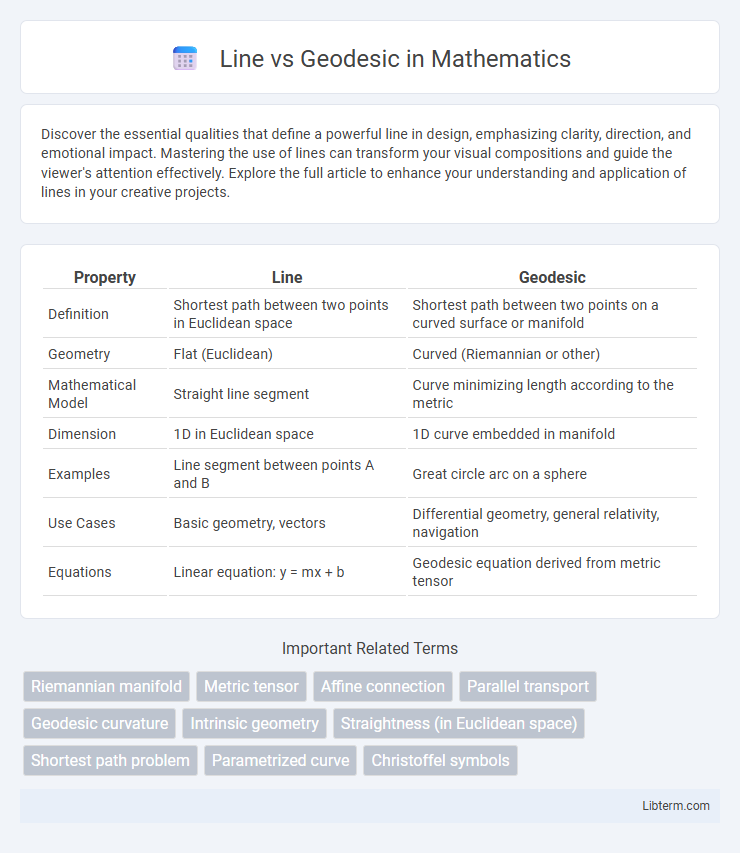Discover the essential qualities that define a powerful line in design, emphasizing clarity, direction, and emotional impact. Mastering the use of lines can transform your visual compositions and guide the viewer's attention effectively. Explore the full article to enhance your understanding and application of lines in your creative projects.
Table of Comparison
| Property | Line | Geodesic |
|---|---|---|
| Definition | Shortest path between two points in Euclidean space | Shortest path between two points on a curved surface or manifold |
| Geometry | Flat (Euclidean) | Curved (Riemannian or other) |
| Mathematical Model | Straight line segment | Curve minimizing length according to the metric |
| Dimension | 1D in Euclidean space | 1D curve embedded in manifold |
| Examples | Line segment between points A and B | Great circle arc on a sphere |
| Use Cases | Basic geometry, vectors | Differential geometry, general relativity, navigation |
| Equations | Linear equation: y = mx + b | Geodesic equation derived from metric tensor |
Introduction: Understanding Lines and Geodesics
Lines represent the shortest distance between two points in flat, Euclidean space, typically visualized as straight paths. Geodesics generalize this concept to curved spaces, defining the shortest or most efficient routes on surfaces like spheres or complex manifolds. Understanding the distinction between lines and geodesics is fundamental in fields such as differential geometry, physics, and computer graphics, where accurate modeling of space and distance is essential.
Defining a Line: Concepts in Euclidean Geometry
A line in Euclidean geometry is defined as an infinitely extending one-dimensional figure with no curvature, straightness, and no thickness. It is characterized by two points that uniquely determine its direction and location, forming the shortest path between them in a flat, two-dimensional plane. Unlike geodesics on curved surfaces, Euclidean lines follow the principles of flat space geometry, making them fundamental elements for constructing geometric shapes and proofs.
What is a Geodesic? Exploring Curved Spaces
A geodesic represents the shortest path between two points on a curved surface, extending the concept of a straight line into non-Euclidean geometry. In curved spaces such as spheres or general relativistic spacetimes, geodesics are defined by the metric tensor governing the geometry, ensuring minimal distance or extremal action. These curves are fundamental in fields like differential geometry and physics, describing natural paths of particles and light in gravitational fields.
Key Differences Between Lines and Geodesics
Lines represent the shortest distance between two points in flat Euclidean space, following a straight path, while geodesics generalize this concept to curved spaces such as spheres or manifolds. Geodesics minimize distance locally on curved surfaces, often appearing as curved paths, unlike lines which are inherently linear and exist only in flat geometries. The key difference lies in the underlying geometry: lines apply in flat, zero-curvature spaces, whereas geodesics adapt to spaces with curvature, preserving minimal distance along those surfaces.
Mathematical Representation of Lines and Geodesics
Lines in Euclidean geometry are represented by linear equations, typically in vector or parametric form, where the shortest distance between two points is a straight segment. Geodesics, generalized in differential geometry, are curves that locally minimize distance on curved surfaces or manifolds and are characterized by solutions to the geodesic equation derived from the manifold's metric tensor. While lines have constant direction vectors in flat space, geodesics incorporate curvature through Christoffel symbols, making their mathematical representation dependent on intrinsic geometric properties.
Lines in Flat vs. Curved Spaces
In flat spaces, a line represents the shortest distance between two points and is characterized by straightness and constant direction. In curved spaces, however, the concept of a line generalizes to geodesics, which are locally shortest paths that may appear curved due to the space's intrinsic curvature. Unlike lines in Euclidean geometry, geodesics account for curvature, making them critical in understanding geometry on spheres, surfaces, and general relativity.
Geodesics on Spheres and Other Manifolds
Geodesics on spheres represent the shortest paths between points, commonly known as great circles, which differ from straight lines in Euclidean spaces by curving along the surface. In differential geometry, geodesics extend this concept to general manifolds, tracing locally distance-minimizing curves that reflect the intrinsic curvature of the space. These curves solve the geodesic equation, governed by the manifold's metric tensor, providing essential insights into navigation, physics, and global shape analysis on curved surfaces.
Real-World Applications of Geodesics
Geodesics represent the shortest paths between points on curved surfaces such as Earth, crucial for optimizing routes in aviation and maritime navigation where straight lines on maps do not account for the globe's curvature. In geospatial analysis and GPS technology, geodesic calculations enable precise distance measurement and pathfinding over the Earth's ellipsoid shape. Civil engineers and architects utilize geodesic principles in designing efficient structures and networks that follow natural curved surfaces, minimizing material use and maximizing stability.
Lines and Geodesics in Physics and Engineering
Lines represent the shortest distance between two points in Euclidean spaces, often used in physics to model straight trajectories and in engineering for designing linear structures. Geodesics generalize this concept to curved spaces or manifolds, serving as the path of least energy or minimal length in general relativity and continuum mechanics. Understanding the distinction between lines and geodesics is crucial for accurate modeling of physical phenomena on curved surfaces, such as planetary motion or stress distribution in deformable bodies.
Summary: Choosing Between Line and Geodesic
Selecting between a line and a geodesic depends on the geometric context and application needs. A line represents the shortest path in flat, Euclidean space, while a geodesic is the shortest path on curved surfaces or manifolds, such as the Earth's surface or a sphere. Geodesics are essential in fields like geodesy, navigation, and general relativity, where accurate distance measurements on curved geometries are required.
Line Infographic

 libterm.com
libterm.com